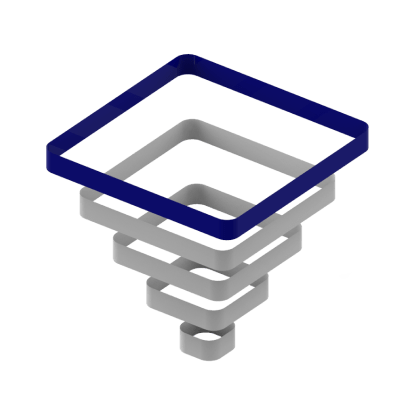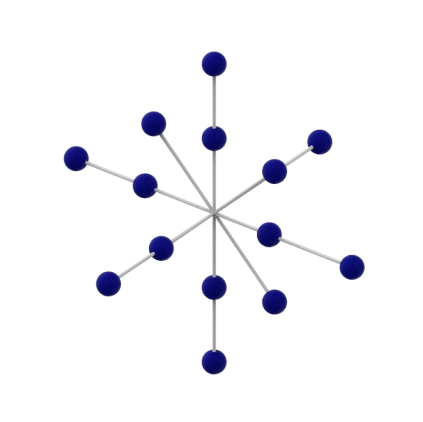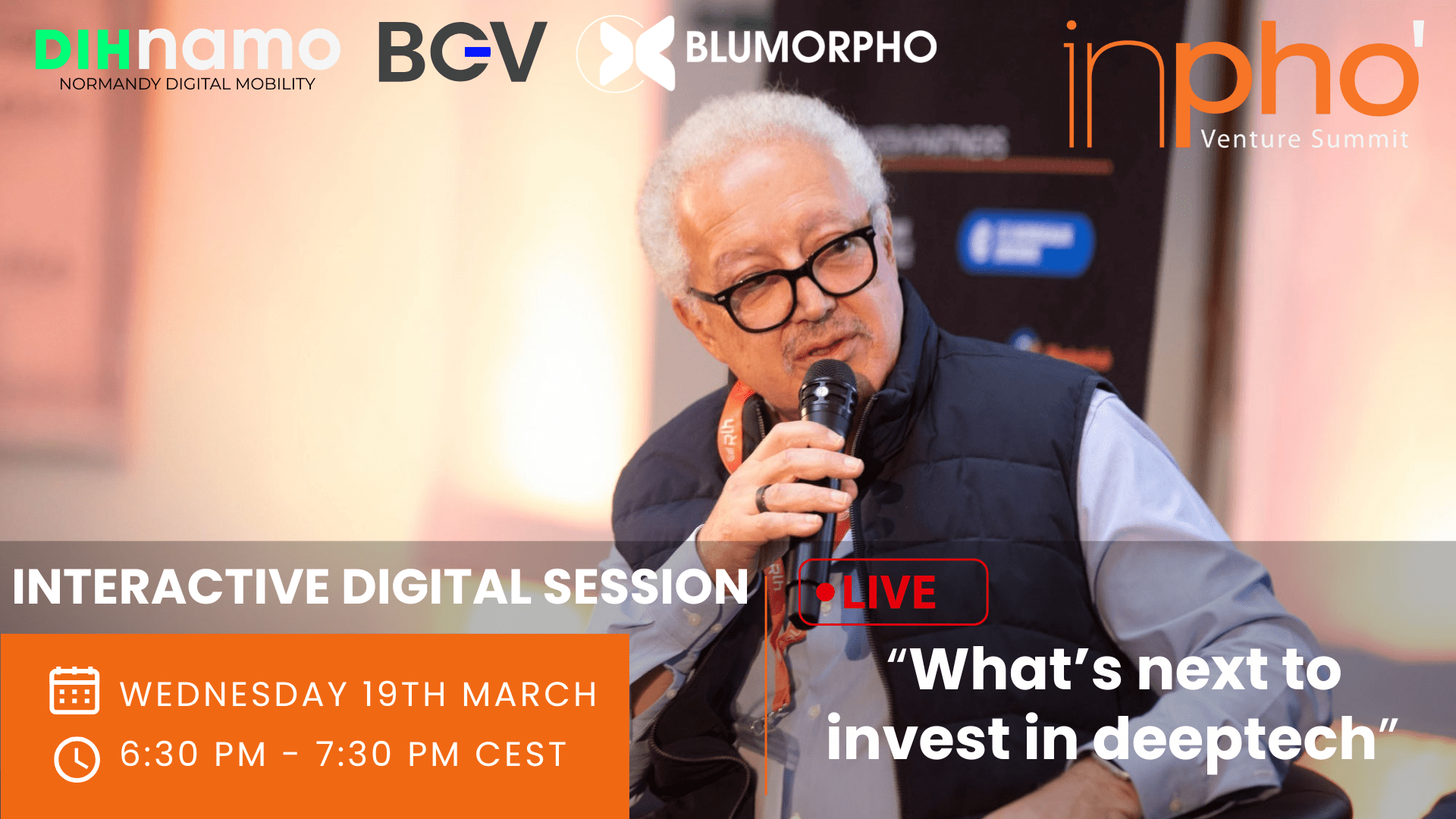The discussion was introduced by Géraldine Andrieux, who set the stage by providing context for the conversation and explaining its relevance. Both she and Eric Benhamou play active roles on the editorial committee of the INPHO Venture Summit, helping to shape crucial conversations about the future of deep tech investment. She acknowledged Eric’s presence and the pleasure of having him taking part to this conversation.
She also extended a warm welcome to all the participants, with a special mention of François Breniaux from Supernova Invest, Christian Claussel from Ventech VC, Emmanuel Daugeras from Karista VC, Marc Lambrechts from Capricorn Partners, Anne Lebreton-Wolf from ALW Finance & Innovation and Rémy de Tonnac from ETF Partners.
This conversation is the result of a discussion started during previous INPHO Venture Summit editions regarding the challenges of pinpointing ‘what’s next’ in deep tech investment. Just a few months ago, in October 2024, the last INPHO Venture Summit, focused on identifying the next big opportunities in deep tech. Since then, so much has unfolded. The objective of the discussion is not only to join INPHO participants but also key stakeholders from across the French and European innovation ecosystems, which promises a particularly exciting and diverse discussion.
The Future of Deep Tech Investment: Challenges in the U.S., China, and Europe
Géraldine Andrieux: Eric, could you share your thoughts on what’s next for deep tech investment? Given our discussions at INPHO and the rapid evolution of AI and other technologies, what are the key trends shaping the landscape?
Eric Benhamou: Since our last discussion in Bordeaux, one of the most significant developments in AI has been the introduction of the DeepSeek-R1 model in January. This was a major milestone for several reasons.
First, it marks a breakthrough from a Chinese company, demonstrating deep innovation not just in software but also in hardware. It reinforces the idea that simply increasing computing power isn’t enough to drive AI forward; smart innovation in architecture plays an equally crucial role. DeepSeek has delivered a significant leap in performance while simultaneously reducing costs, proving that strategic advancements can be just as powerful as raw computational force.
Another key factor is DeepSeek’s commitment to open-source AI. By making its model open-weight, DeepSeek is accelerating AI deployment, particularly in enterprise applications. This isn’t an isolated case. In recent weeks, we’ve seen similar or even greater advancements from Chinese tech giants like Alibaba and Baidu.
This underscores the intensifying global competition in AI, with the U.S., China, and Europe all vying for leadership. China’s research ecosystem, despite restrictions on NVIDIA’s most sophisticated GPUs, has produced world-class advancements. Instead of using H100 GPUs, they have worked with H800 chips, which have lower chip-to-chip bandwidth but have compensated through algorithmic improvements such as quantization and reinforcement learning with reduced human input. Overall, these developments are significant and signal a positive trajectory for AI innovation worldwide.
Rémy de Tonnac: However, Europe, has yet to fully position itself. While companies like Mistral AI show promise, large-scale collective investments similar to an “Airbus of AI” have not materialized. This leaves Europe at a competitive disadvantage compared to the U.S. and China.
Is DeepSeek a scam or a real game changer?
Rémy de Tonnac: A few weeks after the DeepSeek “tsunami,” have we started to understand if the DeepSeek architecture design is indeed significantly different from what has been done before? Does it inherently offer a huge advantage?
Eric Benhamou: There’s broad agreement that the innovations introduced by DeepSeek represent a high-quality breakthrough, reflecting the caliber of their scientists. The innovations fall into two categories: hardware and software.
On the hardware side, the key focus is finding ways around the limitations of not having access to the latest GPUs, particularly when it comes to chip-to-chip bandwidth. DeepSeek’s approach to reducing the amount of data traffic between chips is a key innovation. One such technique is quantization, which allows for faster matrix multiplications, core to AI processes, by reducing the precision of calculations. Essentially, you can drop off the last few digits in calculations, cutting down on computational cost and data movement without sacrificing significant accuracy. This drastically reduces the cost of compute and sidesteps the need for advanced chips.
On the software side, DeepSeek has made significant strides in training efficiency. Training with human feedback (like reinforcement learning) is expensive, so finding ways to reduce the need for extensive human input can save considerable costs. DeepSeek has excelled at this, and much of their software innovation has been published in research papers. The great thing is that these software techniques are available for anyone to use. The hardware innovations are proprietary, but the software advancements are open for the industry.
I think this is a step-function innovation for the AI field, and I believe it will benefit the industry overall. I haven’t looked deeply into the more recent Chinese models from Alibaba and Baidu, but I suspect their approaches are similar, given the competitive landscape.
Christian Claussel: There has been some controversy surrounding DeepSeek, with questions about whether it truly lives up to expectations. Some initial skepticism impacted stock markets, but the concerns seemed to fade over time.
Eric Benhamou: DeepSeek is definitely not a scam and should be taken very seriously. Their team consists of top-tier, highly reputable researchers, and their work has been peer-reviewed. However, there have been discussions about whether some of their training data was acquired under questionable circumstances. In China, where copyright laws are less strict, data access can be more flexible, which might give them an advantage in training efficiency.
What’s also notable is how DeepSeek has been perceived as a real competitive threat. Companies like OpenAI have reportedly sought legal measures to limit its distribution, which is a strong indication that they see it as a viable rival. Rather than blocking access, it would be more constructive for OpenAI to highlight why their model is superior, but instead, we’re seeing restrictions on DeepSeek models entering the U.S. market. This underscores the global battle for AI dominance.
Sovereignty and Geopolitics in AI Development
Anne Lebreton-Wolf: In today’s geopolitical landscape, Sovereignty in AI is a growing concern, more critical than ever. How do you see this shaping AI development?
Eric Benhamou: AI sovereignty is crucial. Training advanced models requires access to vast datasets. China enjoys a strategic advantage here, as its regulatory environment allows nearly unrestricted data access. Meanwhile, strict copyright laws in the West significantly increase training costs.
This naturally raises sovereignty concerns: If AI is truly a matter of national security and economic independence, as many believe, then placing such high costs on model training in the West could drive innovation elsewhere, potentially making us dependent on AI systems developed under entirely different values and biases.
Then there’s the question of regulation. In Europe, for example, the EU AI Act introduces strict compliance requirements for high-risk AI systems. While well-intentioned, some argue that these regulations stifle innovation and impose unnecessary costs too early, which could further disadvantage European AI players.
At the same time, the global AI landscape is becoming increasingly fragmented. Rising trade barriers and geopolitical tensions are leading to isolated AI ecosystems in the US, Europe, China, and other regions. As a result, companies may find it easier—or simply more cost-effective—to train their models in jurisdictions with fewer restrictions, which could influence the way AI develops worldwide.
Ultimately, while everyone agrees that AI is one of the most critical technological innovations of our generation, the landscape is far from even. Sovereignty in AI is about much more than just technological leadership—it’s about economic resilience, security, and control over the future of intelligence itself.
The Rise of Agentic AI and Its Applications
Géraldine Andrieux: AI is evolving rapidly, and we’re seeing the emergence of agentic AI. Eric, could you explain why this is significant?
Eric Benhamou: Agentic AI refers to models that can reason, set goals, break them down into manageable steps, and determine the best course of action through chain-of-thought reasoning. This evolution enables AI-driven agents to go beyond automation; they can interact with existing IT systems, access databases, and participate in process automation—not in a rigid, robotic manner, but with adaptive, reasoning-based intelligence.
This transformation was already underway, but the acceleration of AI models, now cheaper, more accessible, and increasingly capable, has made agentic AI even more viable. This creates a landscape where AI agents and human agents collaborate. AI agents will be auditable. We can track what they do, when they access data, and how they use it. This transparency is crucial for enterprise adoption.
Emmanuel Daugeras: Today, most large language models rely on statistical pattern recognition rather than true understanding of the physical world. There’s growing interest in “physically informed machine learning,” where AI derives differential equations from physical observations. Do you see this as the next big disruption in AI?
Eric Benhamou: Absolutely. Real-world models, those that reflect the physical environment—are key to advancing AI, particularly in robotics. The paradox is that while AI can now solve complex mathematical problems at a PhD level, it still struggles to manipulate objects as well as a toddler. A three-year-old can handle objects with greater dexterity than the most advanced robots today.
This capability gap needs to be closed. Integrating real-world models will be crucial for AI to navigate and interact with its environment more effectively. Back in the 1960s, people envisioned household robots capable of handling daily chores. Yet, even now, we lack robots that can load a dishwasher without breaking plates. This highlights the limitations of current AI and the need for more advanced real-world learning approaches.
Rémy de Tonnac: I completely agree. While the big infrastructure plays are largely dominated by tech giants, the real opportunity for VCs lies in applications leveraging agentic AI to drive productivity gains across industries.
Eric Benhamou: While AI remains a major focus, other deep-tech areas like space and defense are becoming increasingly important. In Europe, significant investments are being directed toward defense, particularly in drone warfare strategies and fleet coordination. Innovations in autonomous systems are shaping modern military tactics, making this a key area for technological advancement.
Space tech is another rapidly evolving field. From reusable rockets to space-based materials research and cyber defense for satellite payloads, there are countless opportunities. Companies working on Space Situational Awareness (SSA) are tackling challenges like collision detection using AI-driven pattern mapping rather than traditional computationally expensive methods.
Emmanuel Daugeras: We’re actively investing in dual-use space tech and defense infrastructure. The demand for AI-powered solutions in these areas is growing, and we’re seeing strong traction. The number of satellites is set to double within a few years, making space traffic management a critical challenge.
Christian Claussel: One of our portfolio companies is developing a Eurocontrol-like system for satellites, helping to manage space traffic. As payloads increase, AI-driven solutions for collision avoidance will become essential.
- European and Global Competition in AI & Quantum Computing, Space Tech and Defense Innovation
Rémy de Tonnac: From a VC perspective, we consider that quantum computing is probably the only area in deep tech where Europe has a real competitive edge. Google’s recent Willow announcement demonstrated a quantum leap—completing computations in five minutes that would take traditional supercomputers trillions of years.
Quantum will revolutionize fields like materials science, chemistry, and genetics. While direct investments in quantum infrastructure may be beyond the typical VC horizon, the real opportunity may be in developing the “picks and shovels”. In quantum computing, this could mean developing the tools and software that will accelerate its adoption.
What areas of deep tech hold the most promise for European competitiveness according to you?
Eric Benhamou: Quantum computing is indeed one such area where Europe has a competitive edge. While AI remains a major focus, other deep-tech areas like space and defense are becoming increasingly important. In Europe, significant investments are being directed toward defense, particularly in drone warfare strategies and fleet coordination. Innovations in autonomous systems are shaping modern military tactics, making this a key area for technological advancement.
Space tech is another rapidly evolving field. From reusable rockets to space-based materials research and cyber defense for satellite payloads, there are countless opportunities.
Emmanuel Daugeras: We’re actively investing in dual-use space tech and defense infrastructure. The demand for AI-powered solutions in these areas is growing, and we’re seeing strong traction. The number of satellites is set to double within a few years, making space traffic management a critical challenge. Companies working on Space Situational Awareness (SSA) for example are tackling challenges like collision detection using AI-driven pattern mapping rather than traditional computationally expensive methods.
Christian Claussel: One of our portfolio companies is developing a Eurocontrol-like system for satellites, helping to manage space traffic. As payloads increase – the fleet estimated around 35,000 satellites today is expected to double in just three or four years – AI-driven solutions for collision avoidance will become essential.
Investment Strategies in AI: Infrastructure vs. Applications
Christian Claussel: At Ventech, rather than predicting the next big AI trend, we focus on what AI is already doing today. AI isn’t a sudden revolution—it’s been evolving for decades. I remember visiting a Fraunhofer Lab in 2001 where AI research was already well underway. What has changed is that computing power has finally caught up, allowing AI to reach its full potential. The key question for us is: where do we invest? In infrastructure, software, or new algorithms?
Eric Benhamou: As a VC, we don’t play in the massive infrastructure investment space, so we focus on high-value applications. For example, we wouldn’t make a $10 billion investment in a company like Mistral AI. It’s not that they aren’t competitive, but it’s simply not our swim lane.
Our strategy centers on young companies that leverage AI to drive productivity gains. Right now, the biggest opportunity lies in agentic AI—models that use reasoning-based intelligence rather than just automation. These systems dynamically solve business problems, interacting with IT systems, querying databases, and adapting decisions in real-time.
This creates a new landscape where AI and human agents collaborate. AI agents will be fully auditable, ensuring transparency in how they process data, making them viable for enterprise adoption.
That said, France has some of the world’s best mathematicians, but too many focus on algorithmic research rather than business applications. The real opportunity is in companies applying AI to solve concrete business challenges rather than just developing theoretical models. This is where the best returns will come from.
Challenges and Opportunities in AI Monetization
Emmanuel Daugeras: AI engines, to some extent, face the risk of becoming commoditized. AI engines consume massive amounts of energy and require huge capital expenditures. While they are transformative, how do you see real value being captured in AI?
Eric Benhamou: That’s a fundamental question. What’s the return on AI? While AI innovation is unquestionable, monetizing it remains a challenge.
In our view, the highest returns will come from AI-enabled applications and services. Infrastructure investments, though critical, are mainly reserved for well-funded firms. Companies like Mistral AI are exceptions—they are well-financed and have strong technology—but generally, infrastructure is a game for the tech giants.
AI-enabled services, however, span across industries. Software development, for instance, is already experiencing major transformation. AI-powered coding assistance tools are boosting developer productivity to the point where some Silicon Valley companies have reduced engineering headcount, not due to financial struggles, but because AI has made development more efficient.
Beyond software, customer-facing industries like financial services and insurance are seeing AI-driven automation in customer support and decision-making. These areas will yield the strongest AI-driven productivity gains and financial returns.
Climate Tech and Energy Management
Géraldine Andrieux: Climate tech is a critical area. How do you see AI playing a role in energy management?
Eric Benhamou: I think there’s a crucial area of innovation here that many of us can agree on. We now need to harness a wide range of energy generation sources—solar, wind, nuclear (depending on the region), and others—into what we call virtual power plants. These virtual power plants are much more distributed and utilize various forms of energy generation and transportation.
To better manage energy, we need software constructs to pull all of these resources together. For instance, a small community could aggregate all of its solar power from rooftops into one unit, and manage that alongside a larger physical plant somewhere in the region. This requires holistic management in the form of virtual power plants.
AI is going to play a significant role here, improving utilization, balancing loads, and preventing energy waste. While there will certainly be innovations in physical energy generation and storage—areas we still know less about—what we understand more clearly is how to manage these systems efficiently.
This intersection of AI and climate tech is going to be extremely interesting, and it’s something we’ll certainly be paying attention to. In Europe, particularly with the ongoing Russia-Ukraine conflict and the subsequent shifts in energy sources, including the reevaluation of nuclear power, we’re seeing massive changes. This will result in a more diversified and distributed energy generation base.
The only way to manage this smartly is through virtual power plants. So, there are a lot of interesting problems to solve here, and I think this area is a fertile ground for startups.
Rémy de Tonnac: One of the companies I’ve invested in is already implementing multiple AI models to balance grid efficiency. Quantum computing is also being explored for energy optimization, further enhancing the potential of AI-driven energy management.
Marc Lambrechts: A key focus here is data, especially data quality. In health applications, reliable data sources are crucial for AI systems. I’m particularly interested in Voxel Sensors, one of our portfolio companies, which is developing a hardware solution combining depth sensing with eye scanning to gauge intent or attention. They’re focusing on both hardware and software, ensuring data quality for future visual language models. While major AI players focus on compute power and data volume, Voxel is innovating in data quality, adding unique value.
Eric Benhamou: I agree—data quality is essential for successful AI deployments. AI failures often stem from poor data curation, which hinders model training and insight generation. Improving data quality is critical for AI productivity gains.
Beyond data quality, data governance is vital—ensuring secure access and combating issues like fake news. As the world faces more conflicts and cyber threats, the demand for sophisticated cybersecurity tools will grow. Some threats may involve disinformation campaigns or AI agents posing as humans to disrupt systems.
The cybersecurity market will continue to expand, and while we may face competition in other sectors, its growth is assured. Additionally, space tech presents exciting opportunities, with France being a leader in space technology.
VC Market Trends and Challenges
François Breniaux: AI is taking up a significant portion of venture funding. What does this mean for other sectors? Can you be a successful investor today without investing in AI?
Eric Benhamou: While AI dominates headlines, sectors like energy storage, materials science, and healthcare still offer strong investment opportunities.
The VC market is still recovering from the 2022 downturn. In 2021, overinvestment led to inflated valuations and wasteful spending, followed by a sharp correction.
Today, U.S. venture investment levels are similar to those of a decade ago, effectively wiping out years of growth. AI now takes the lion’s share of funding, leaving sectors like climate tech underfunded. However, I anticipate a surge in defense tech and cybersecurity investments in the coming years.
Géraldine expressed her gratitude to Eric for his strong statement, emphasizing the importance of not only considering the technology but also the current state of the VC market and the wealth available in the venture capital world. She thanked Eric for his time and insightful contributions, noting how much they were appreciated. Géraldine also extended her thanks to all the participants for joining the conversation, highlighting how valuable the discussion had been. She concluded by mentioning that the next INPHO Venture Summit will take place in Bordeaux in 2026, inviting everyone to join what promises to be an excellent opportunity to connect with both investors and industry professionals.
 Start-up mode® for Corporate InnovationCorporates collaborate with us to generate and operate new value propositions and attractive business models.
Start-up mode® for Corporate InnovationCorporates collaborate with us to generate and operate new value propositions and attractive business models. Deal flow and Customers acquisitionFor Corporates and Entrepreneurs to activate high value collaboration and investment opportunities
Deal flow and Customers acquisitionFor Corporates and Entrepreneurs to activate high value collaboration and investment opportunities












